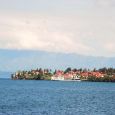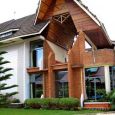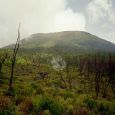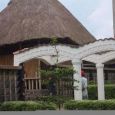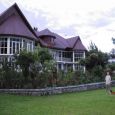Goma
Advertisement
By Air
There are several flights from many towns of Congo to Goma.There is a daily flight from Kinshasa to Goma which is operated by CAA and Wimbi Dira Airways.Alternatively, it is possible to fly to Kigali -in neighboring Rwanda- by direct flights from Europe (France, Belgium, Germany), then by road to Goma (taxi (70- 100 USD) or collective bus (10 USD).
By Bus
From Kisoro, Uganda, you can take a minibus in Bunagana at the Uganda border.From Rwanda there are hourly minibuses from Kigali to Goma,such as Atraco Express and Okapi Car.These will take approximately three and a half hours.From Butembo you can fund a Bus in Butembo bus station.They may leave early in the morning.
By Ferries
There are daily ferries from Bukavu via Idjwi Island.There are several companies that offer the 2-5 hour trip. Prices vary from 10 USD to 40 USD.
Mount Nyiragongo
Is a stratovolcano in the Virunga Mountains associated with the Great Rift Valley.It is located inside Virunga National Park, in the Democratic Republic of the Congo, about 20 km north of the town of Goma and Lake Kivu and just west of the border with Rwanda.The main crater is about two km wide and usually contains a lava lake.The crater presently has two distinct cooled lava benches within the crater walls one at about 3175m (10,400 ft) and a lower one at about 2975 m (9800 ft).Nyiragongo's lava lake has at times been the most voluminous known lava lake in recent history.The depth of the lava lake varies considerably.A maximum elevation of the lava lake was recorded at about 3250 m (10,700 ft) prior to the January 1977 eruption a lake depth of about 600 m (2000 ft).A recent very low elevation of the lava lake was recorded at about 2700 m (8800 ft).Nyiragongo and nearby Nyamuragira are together responsible for 40% of Africa's historical volcanic eruptions.
Virunga National Park
The national park covers the western shores of Lake Edward, known for its hippopotami depleted by more than 95 percent in 2006 while elsewhere, marshland, grassland plateau and plains dominate the park.The Ruwenzori Mountains lie on the Ugandan border and rise to alpine meadows and a glacier, while Nyiragongo and Nyamuragira are both active volcanoes with substantial associated lava plains.The park is known for its exceptional diversity, containing more bird, mammal and reptile species than any protected area on the African continent. Although mountain gorillas are now extremely rare and listed as one of the most critically endangered species, successful conservation work has helped to secure the remaining populations.Their populations actually increased during the years of political upheaval in the region (1994–2004),but renewed military conflict in the park (October 2008) including the seizing of the park headquarters and expelling of park rangers, poaching, and rampant deforestation for illegal charcoal production once again cast doubt on their future.
Rwenzori Mountains
Is a mountain range of central Africa, often referred to as Mt. Rwenzori, located on the border between Uganda and the DRC, with heights of up to 5,109 m (16,761 ft).The highest Rwenzoris are permanently snow-capped, and they, along with Kilimanjaro and Mount Kenya are the only such in Africa.The mountains formed about three million years ago in the late Pliocene as a result of an uplifted block of crystalline rocks such as: gneiss, amphibolite granite and quartzite,"pushed up by tremendous forces originating deep within the earth’s crust".This uplift divided the paleolake Obweruka and created two of the present-day African Great Lakes: Albert and Edward and George on the flanks of the Albertine (western) Rift of the East African Rift, the African part of the Great Rift Valley.
Lake Kivu
Is one of the African Great Lakes.It lies on the border between the Democratic Republic of the Congo and Rwanda, and is in the Albertine (western) Rift, a part of the Great Rift Valley.Lake Kivu empties into the Ruzizi River, which flows southwards into Lake Tanganyika.The name comes from kivu which means "lake" in Bantu language, just like the words tanganyika or nyanza.Native fish include species of Barbus, Clarias, and Haplochromis, as well as Nile Tilapia.Limnothrissa miodon, one of two species known as the Tanganyika sardine, was introduced in 1959 and formed the basis of a new pelagic zone fishery.In the early 1990s, the number of fishers on the lake was 6,563, of which 3,027 were associated with the pelagic fishery and 3,536 with the traditional fishery.Widespread armed conflict in the surrounding region from the mid-1990s resulted in a decline in the fisheries harvest.
Information not available


